Changing communities,
changing lives.
Navigation
What Musicians Say

Gregory Blankenbehler, M.A. Mus.
"The Little Musician software program by BrillKids is the closest thing I have seen yet to an easily-accessible early music education of the kind that gave us musical geniuses like Mozart and Bach..."
Like Us On Facebook!
Give your child a head start in music!

by

Ideal for babies and young children, Little Musician is the most effective learning system for teaching your young child mathematic concepts.
At the heart of Little Musician is a revolutionary software system that delivers lessons in ways never before possible, making learning ENGAGING for your child and teaching EASY for you.
Get a FREE Trial Email BrillKids
What Will My Child Learn?
Here are the main things your child will begin to learn with Little Musician:
Sing in Solfege
Your child will learn to sing music notes in Solfege (do, re, mi, etc.), and develop the most important instrument your child will ever have - the voice box!
Develop a 'Good Ear'
Your child will learn to recognize notes and chords she hears, and thereby improve her sense of sound and pitch.
Sight-Read Music
Your child will learn to identify notes that are written on the musical staff, allowing her to be able to sight-read written notes and simple melodies.
Sense of Rhythm
Through 'clap-along' lessons, your child will start to develop the ability to move in rhythm to music. 'Rhythm Syllables' lessons also will teach your child to sight-read music with different rhythms.
Musical Instruments
Your child will learn about all major instruments (string, brass, woodwind, keyboard and percussion) as she hears the sounds they make and sees the way they are played.
Classical Music and Composers
Your child will get acquainted with famous composers and compositions (baroque and classical, romantic, and modern popular classics) through the different classical pieces played daily.
Musical Keyboard
Your child will also gain familiarity with the musical keyboard and how each key corresponds with the different pitches and Solfege syllables.
What's so special
5-Minute Daily Lessons
A pre-planned 1 year curriculum removes any need for you to think about what you should teach your child each day. All you need to do is press 'PLAY' and have fun interacting with your child as the lesson progresses!
Furthermore, lessons are deliberately designed to last approximately five minutes each day to cater to young children's short attention spans and make it easy for you to fit this into your regular daily routine. The key to success is not length of time, but consistency!
Customization
Little Musician is not just wonderful music content you can show your child. It is also a powerful platform for you to deliver music lessons the way you want to!
Prefer a different presentation style that's more suitable for your child? Simply customize the lessons or even create your own lessons that are exactly tailored to your child's needs! Little Musician gives you unparaleled flexibility in customization and freedom to personalize lessons the way you want to.
Variation
With Little Musician, not only is the lesson content different every day, but even the same day's lesson plays back differently each time! This is made possible by randomization and rotation features in the software that pull from the vast media resources (including different pictures, audio and video) that constitute Little Musician.
For example, when learning about the violin, your child will see and hear from amongst 5 different pictures, 2 different video animations, 3 different pronunciations and 3 different violin samples.
Interactive
Little Musician is designed to be an interactive experience with full involvement by you. Throughout the lessons, your child will be encouraged to listen, sing, move, clap, and guess at the sounds she hears and notes she sees.
Appropriate for all ages
Even though Little Musician was designed with infants and toddlers in mind, it is suitable for children of all age groups. In fact, even many of the parents are saying that they themselves are learning a lot!
Get a FREE Trial Email BrillKids
Learn More About The Curriculum >
About the Music Curriculum
The Structure of the Curriculum
The Little Musician curriculum is spans a period of two years, with four semesters of six months each. Based on a five-day week, each semester comprises 130 days of lessons.
Each day's session is made up of a number of different lessons. For example, a day's session in Semester 1 contains the following lessons:
Chord Recognition 1
Music Appreciation (short)
Note Sounds
Solfège 1
Music Knowledge
Chord Recognition 2
Solfège 2
Exercises
Clap-Along
Music Appreciation (long)
Lesson Types
In Semesters 1 and 2 of the curriculum, you will see these types of lessons - more than once a session in some cases:
1. Chord Recognition
There are nine chords that we want your child to be able to recognize instantly. (For you musicians, these are the C, F, and G chords, in root, first inversion and second inversion.) The chords are played with instruments, and sung out in solfège. Examples are "domiso" for the C Major (root) chord, and "falado" for the F Major chord. Together, the nine chords cover all the notes of the C Major scale (white keys). This is similar to the Eguchi method used in Japan, which some consider to be the best way to foster 'perfect pitch' and which apparently has produced a very high success rate.
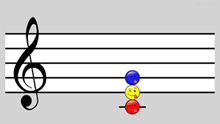

2. Note Sounds
This is the most basic of lessons, and lets your child associate pitch with the written note on the musical staff. It's a good way to show how higher pitched notes are written higher and lower pitched notes lower. Random instrument sounds are used each time.


3. Solfège
These lessons teach individual notes in solfège (eg., Do, Re, Mi), with notes shown on the musical staff. Your child will start associating pitch with the note position on the musical staff, as well as with the relevant solfège syllable. Semester 1 focuses purely on C Major. Semester 2 introduces solfège in F Major. Lesson slides are forwarded manually because we want to encourage you to take your time to interact with your child. During the lessons, it's very important to sing out the note you hear, and - if possible - encourage your child to sing it out, too.


4. Exercises
These are exercises which help train the ear (Hear and Sing), and help to promote sight-reading of notes (See and Sing). Hear and Sing exercises train both chord recognition, as well as individual note recognition, encouraging your child to listen to the chord or note, and sing it out in solfège. See and Sing exercises show notes on the musical staff and encourages your child to sing it out in solfège, similar to how your child would read out words or sentences.

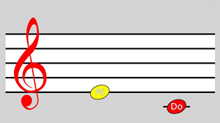
5. Clap-Along
Clap-Along lessons are designed to give your child an introduction to rhythm and beats. During these lessons, children songs (such as Twinkle, Twinkle Little Star) are played, and your child is encouraged to clap along to the beat. Different beat rhythms are introduced as the curriculum progresses.

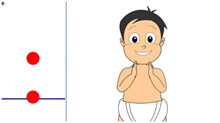
6. Music Knowledge
In these lessons, your child will get to learn more about how music is made. First, your child is introduced to different musical instruments (eg., violin, trumpet, clarinet), hear what they sound like, and see how they are played. Second, your child will also learn more about famous classical composers (eg., Bach, Mozart, Beethoven) and some of the famous pieces they composed.



7. Music Appreciation
The aim of these lessons is to expose your child to classical music, and through the exposure, let her gain familiarity with (as well as appreciation of) classical music. These lessons include clips from fifty of the most popular classical pieces, such as Beethoven's Fifth Symphony and Handel's Hallelujah Chorus.

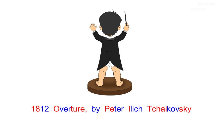
8. Rhythm
Rhythm lessons will introduce your child to rhythm syllables, such as "Ta" for quarter notes/crotchets, and "Ti" for eighth notes/quavers. Rhythm syllables are a good way to learn how music notation on the musical staff indicate different lengths of time, and therefore how rhythm is notated. Rhythm lessons start from Semester 2.
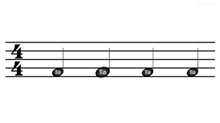

9. Scales
Through these lessons, your child will see and hear different scales in different keys. Lessons cover both major scales as well as the different minor scales (harmonic, melodic and natural), and are played out using instruments as well as with solfège voices. Scales lessons start from Semester 2.

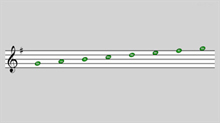
10. Keyboard
Keyboard lessons will introduce your child to the keyboard, showing how the different black and white keys of the keyboard correspond to the different solfège notes and music pitches. Instead of perceiving the keyboard as an overwhelming sea of black and white keys, your child will see them in distinct groups made up of lower to higher octave patterns. Keyboard lessons start from Semester 2.


< Little Musician Learning System Frequently Asked Questions >
Frequently Asked Questions
What age is Little Musician suitable for?
Little Musician was largely designed with infants and toddlers in mind.
However, like with Little Reader, the suitability depends not so much on the age, but on the level of familiarity the child already has with the musical concepts being taught.
We have therefore seen children from very different age groups enjoying Little Musician. In fact, even adults who were previously unfamiliar with music concepts appear to be benefiting from it.
What if my baby cannot talk/sing yet?
Even if your baby/toddler is not able to talk or sing, you should still sing out to your child and encourage her to sing along as best as she can. Listening to a 'live' voice is much more effective than just listening to recorded audio that's played out through computer speakers.
What if I can't sing in tune?
Of course, it would be preferable that your singing is in tune. However, your singing is very likely to be better than you think it is, and the advantage of 'live' singing probably outweighs any pitch inaccuracies that you might have. If in doubt, sing, and sing shamelessly! Who knows, you may even improve your singing the more you do it! At the very least, you are giving your child the message that singing is a natural thing that is nothing to be shy or embarrassed about.
Can this replace music classes?
No. Little Musician is not a substitute for music classes, especially where learning a musical instrument is concerned.
However, we expect that Little Musician will likely make it easier for your child to learn an instrument since many of the musical concepts that are required in the learning of the instrument will already be familiar to your child. Having a better-developed ear for music and note recognition will certainly also help with any instrument your child may choose to learn.
And lastly, Little Musician may also serve to give your child a much wider understanding of music in areas which may not be covered in the music classes.
What type of music classes would you recommend?
We like music classes that encourage singing in addition to the learning of music instruments. Classes which use solfège will most likely do that.
Group classes may also have an advantage over private classes if they incorporate group activities like ensemble playing or group singing, or give your child opportunities to perform in front of the other students.
If the course involves exams and grades, we would recommend you find out how much time is spent on practicing set pieces with the goal focused on doing well in the exams, and how much time is spent more on understanding and enjoying the instrument or enjoying music. If the course is more exam-centric, then consider whether this may help to diminish (or even completely kill) your child's enjoyment of music and playing the instrument.
Why does Little Musician seem unconventional in many ways?
There are many ways that Little Musician is unconventional, especially when compared to classical music training. For example:
No Note Stems - Most of the lessons omit the note stem and show only the note head. The reason for this is that the aim of the lessons is to highlight how the positioning of a note on the musical staff (higher/lower) corresponds to its pitch. We believe there is greater clarity and focus when do not deal with note stems and note values. To teach note values, we use dedicated rhythm syllable lessons that are introduced in Semester 2.
Different colors and icons for note heads - We primarily use rainbow colored-notes for easier solfège association. We also substitute fun icons like baby faces in place of note heads to make lessons more enjoyable and fun for the child.
Accidentals instead of key signatures - Our general preference is to show accidentals beside the note instead of showing the key signature, in order to make the accidental more obvious to the child.
Other markings and highlight effects - You will also notice that we often highlight or use colors to emphasize certain things. For example, when notes are played, we often show a green highlight of the entire line or space of the staff in order to make the note's position more obvious.
Solfege system - For those familiar with solfège, we chose to use "So" and "Ti" instead of "Sol" and "Si", although you will be able to change this manually. We also use different syllables for black keys, such as "Di" for C#. Lastly, we chose to use the Fixed Do system over Movable Do as this is more consistent with our efforts to teach note and chord recognition.
Note Names - In Semesters 1 and 2, we do not use note names (C, D, E, etc.) at all. As mentioned, the focus is on solfège, so as to encourage the singing out of the notes. Note names will be introduced in Semester 3.
Treble/Bass Clef - In Semesters 1 and 2, we also focus primarily on treble clef when the musical staff is shown, and not the bass clef. Bass clef has more prominence in Semester 3.
Other things you may also wish to note:
There are problems with the sound!
Those of you with older / slower computers may experience problems with some of the lessons playing back smoothly, in particular, the Rhythm lessons or songs presets which play out voice audio in real time. These lessons require a lot of computer power which older computers may not have.
The sound quality of the instruments you hear also depends on the quality of your computer's sound card. Computers with old or low-budget sound cards may reproduce instrument sounds (such as during the children songs) that sound unrealistic or 'computerized'.
< The Curriculum What Experts Say >
Little Musician Review

Gregory Blankenbehler is a recognized expert in singing and music education for children, and is the author of the popular Singing Lessons for Little Singers method series.
With over 25 years of experience training, performing and teaching music, he has performed in Italy, England and France and holds advanced degrees in Music and Education. He is the music director of John Adams Academy and maintains a large studio of voice and piano students in the Sacramento, California area. He can be reached at his homepage, www.GBMusic.me.
by Gregory Blankenbehler, M.A. Mus.
There is an unfortunate, persistent myth in many of our cultures today that music is simply a medium of entertainment, and that it is best left up to those lucky few who are born with talent. But a growing consensus of research is showing something quite the opposite: music education makes people smarter, healthier, and more successful in life, regardless of whatever "talents" they are born with. Recent studies have shown music study to cause greater physical development in the brain, 1 and up to 27% higher math, 2 57 points higher SAT 3 and 46% higher IQ scores. 4 It has also been shown to have a strong correlation with improved reading and test-taking skills, better behavior, decreased anxiety, and higher grades in school. 5
The myth of the "born musical genius" is also being disproven as research is showing it is nurture, not nature that accounts for most of the musical skills that leave us in awe. It is well known in the field of child development that there is a crucial window between birth and about 6 years old during which a child makes extraordinary progress in language development. Not only does a child learn all of the structure and fundamentals for their own native language at this time, but if they are taught a foreign language during this window they can also speak that language like a native for the rest of their lives. The potential to learn and develop incredible abilities is almost without limit during this once-in-a-lifetime formative window, and is accordingly used to an advantage by early education programs such as Little Reader and Little Math.
"...music education makes people smarter, healthier, and more successful in life, regardless of whatever "talents" they are born with."
What is not perhaps as well understood is that musical abilities operate in much the same way as language, and that they are learned and developed almost identically. The amazing "language-learning window" opportunity from birth to 6 is also a window for unequaled musical skills development. Shinichi Suzuki, founder of the Suzuki method and one of the foremost experts on child music education, understood this concept and promoted the study of music by very young children (ages 3 and up), calling it "talent education." He believed that extraordinarily skilled musicians were made, not born, and he proved it by taking in hundreds of common, every-day children and training them to be some of the finest violinists in the world. Suzuki's philosophy is well summed up in his own words: "The purpose of [music] education is to train children, not to be professional musicians but to be fine musicians and to show high ability in any other field they enter." There is no telling to what heights children can attain if we educate them properly right after birth." 6
Recently, researchers have discovered that absolute pitch recognition ability (often called "perfect pitch") is not simply a rare super-human ability that only a few are granted through lucky genes, but a language skill that nearly all babies are born with. Most babies are born hard-wired to develop perfect pitch, but most do not receive the right stimulation to develop and retain the skill for the rest of their lives. 7
Since formal music lessons typically do not start until about age 6, at the close of the "language-learning window," very few children have been afforded the kind of music education that allows for extraordinary skill development. Mozart and Bach are notable exceptions. Both had fathers that were active composer-musicians and were exposed to the rudiments of music every day from even before they were born. Both were also the younger sibling of another family member who studied the keyboard, and heard every single exercise and song well before they could play them. Both became child prodigies, far surpassing their older siblings, and are now known as the two most famous composers ever. Were these two musical geniuses simply born with more talent than anyone else? Perhaps they were born with some helpful predispositions, but their success cannot be attributed to just that. Mozart and Bach had the unusual opportunity to receive an extraordinary education in music from the day they were born, and that is what caused them to be extraordinary composer-musicians. So, since we are not all composer-musicians ourselves, must we give up now on our children ever receiving this kind of music education? Not at all. Technological advances today allow children to receive musical exposure and training that before was only available to the very lucky (or rich). The classics that before could only be heard by assembling a large group of expert musicians can now be played any time of day with the touch of a button. Never before in history has such a wealth of "nutritious" music been available to so many so easily.
"The Little Musician software program by BrillKids is the closest thing I have seen yet to an easily-accessible early music education of the kind that gave us musical geniuses like Mozart and Bach."
But effective early music education goes far beyond simply putting on a "Mozart for Babies" CD. The Little Musician software program by BrillKids is the closest thing I have seen yet to an easily-accessible early music education of the kind that gave us musical geniuses like Mozart and Bach. Designed to be used daily with children starting at about 6 months, Little Musician teaches musical skills in the same way that children learn language. With the help of a parent (who needs no more musical skill than simple dedication), babies are exposed to the rudiments of melody, harmony, rhythm, and meter in a structured and compelling manner that slowly but powerfully builds their musical language skills. Before the child has ever even begun studying a musical instrument they can identify a melody or chord in solfège, read pitches and rhythms on treble and bass clef staves, point out the correct key on a piano for a given note, and identify musical instruments, famous works, and the composers that wrote them.
Little Musician is designed to be a pre-music-lessons music education. Instead of focusing on musical performance as later instrumental lessons do, it simply teaches children to correctly hear and understand musical language. Using the 900-year-old system of solfège, students learn to recognize and identify individual pitches, intervals, and chords. (Even in the testing stage, parents have been reporting that their children have developed perfect pitch through the program.) From day 1, they also learn to read those pitches on the musical staff. By piecing together basic melodic and rhythmic patterns common to the western musical tradition, children not only learn to correctly read and sing music, but they also become true composer-musicians that have an innate sense for good music and can create their own. The program also teaches them about different musical instruments (from the violin to the banjo) and composers (from Vivaldi to Gershwin) and well-known songs (including many classical masterpieces and children's songs).
Having passed through the curriculum of Little Musician, any child will be ready to make much more effective use of private music lessons and become exceptionally successful. Besides having already learned how to hear and read music correctly, they will bring a wealth of knowledge and experience that will make their playing much more artistic and natural. And most importantly, they will love playing music! Music has been languishing in our world because too many of us think of it as frivolous entertainment. But recent research is showing what our societies used to know, and what the ancient Greek philosophers taught: high-quality music is education of the highest degree. It promotes mental development and helps students do better in math and reasoning. It teaches aesthetics, history, and cultural appreciation in a way that no other subject can. It promotes appropriate behavior, balanced emotions and healthy relaxation. As one of the most powerful forces in the world (think about the influence one popular song can have over millions), music has the potential to raise us collectively to a higher level of thought and action. But just like any language, it is a learned skill. May we all promote its effective study and use.
1
G. Schlaug, L. Jancke, Y. Huang and H. Steinmetz, "In vivo morphometry of interhem ispheric assymetry and connectivity in musicians," Proceedings of the 3rd international conference for music perception and cognition (Liege, Belgium, 1994) pp. 417-418.
2
Amy Graziano, Matthew Peterson and Gordon Shaw, "Enhanced learning of proportional math through music training and spatial-temporal training," Neurological Research 21 (March 1999).
3
College-Bound Seniors National Report: Profile of SAT Program Test Takers. The College Entrance Examination Board, Princeton, NJ, 2001.
4 Rauscher, Shaw, Levine, Ky and Wright, "Music and Spatial Task Performance: A Causal Relationship," University of California, Irvine, 1994.
5
For a list of additional studies on the benefits of music, go to http://littlesingers.info/parents/why-study-music-studies-showing-amazing-benefits-of-music-education/.
6
Shinichi Suzuki, Nurtured by Love, 2nd Ed., Athens OH: Senzay Publications, 1983, pp. 79, 15.
7
Sadie Dingfelder, "Pitch Perfect," American Psychological Association 36:2 (Feb 05), p 32.
For more information on Perfect Pitch, see my article at
http://pitchperfectmusic.org/articles/perfect-pitch-recognizing-notes-thin-air/.
